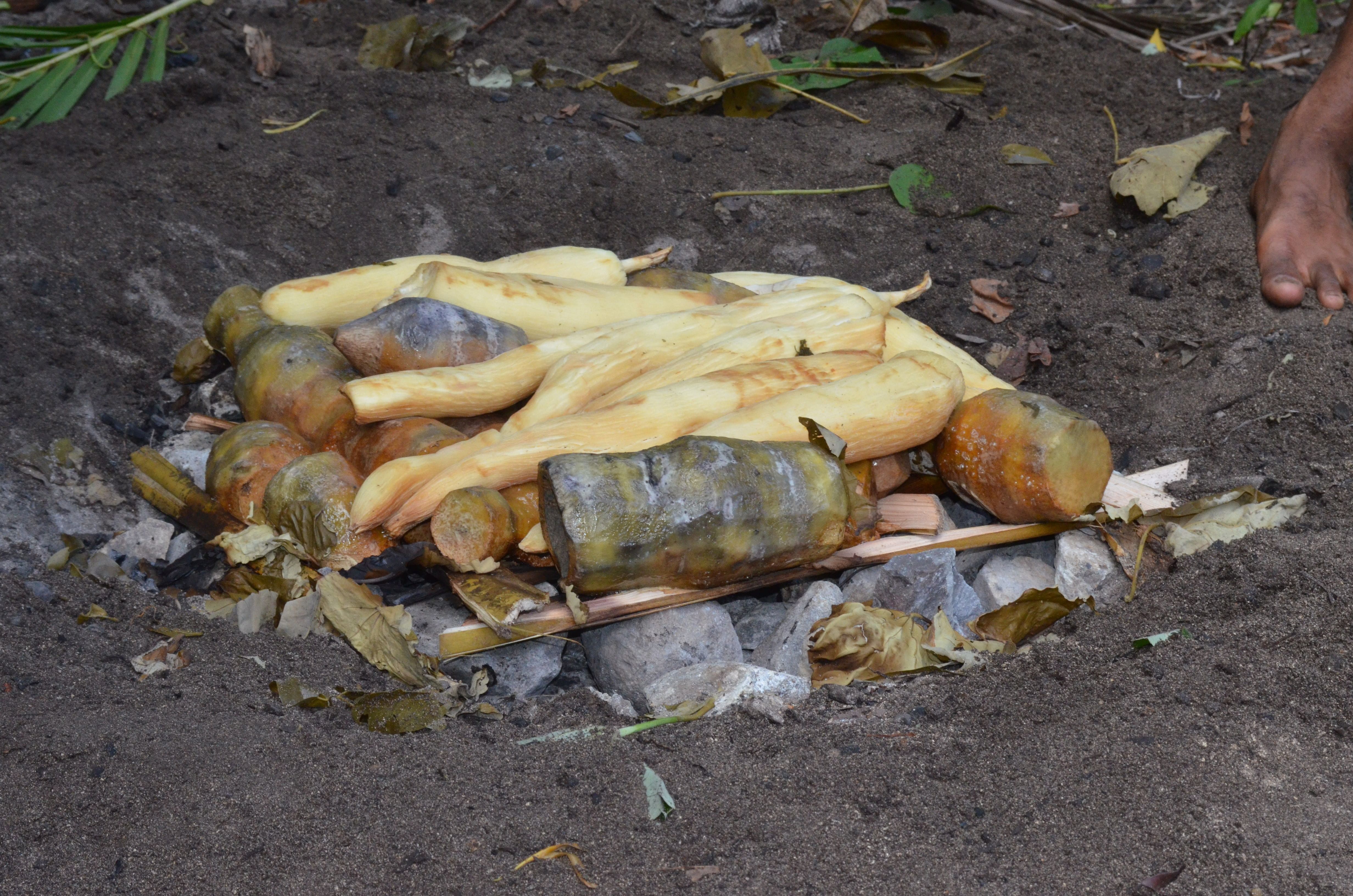
Fijian lovo of cooked staples.
Credit: Wikipedia
There is very little doubt that the one thing that placed us human beings well ahead of any other species was our mastery over the element of fire. Thus, giving our early ancestors a wealth of new powers. The chief being, the containment and manipulation of fire to their great advantage. We know this because archaeologists have unearthed primitive ‘earth ovens’ around the world. With the oldest being found in Central European sites such as Pavlov VI in modern-day Czechia (The Czech Republic). There, researchers discovered an underground barbecue pit dating back approximately 29,000 years.
B(re)aking Bread
The ovens found at Pavlov VI and elsewhere consist of large pits dug into the ground and lined with stones. When it was time to cook a meal, hot coals were loaded into the oven to heat the stones. Meat was wrapped in leaves and placed on top of the ashes before the whole oven was covered with mud and the meat roasted slowly over many hours. But here’s where things take an interesting turn. The bones and other fragments found around the oven at Pavlov VI suggested that one of the last meals cooked in it was a woolly mammoth along with a few loaves of bread! Interestingly, we need not even go back so much in time to understand this unique, very basic cooking technique. For, to this very day, there are several cultures around the world that employ pit and earth ovens to cook up meals. Feasts large enough to feed an entire community. Thus, bringing together two very basic needs of every society: the need to feed and be fed and to be part of a gathering of fellow members.
Polynesia to Scandinavia
Called a hangi by the Maori people — who were the original inhabitants of New Zealand way before the British colonialists — this iteration of a pit oven feast is cooked in a hot stone-lined pit called an umu. In a sort of culinary tradition, not only is the hangi technique passed down, but even the stones themselves, are said to have been handed down for generations. These are used to cook huge quantities of meats such as lamb, pork, chicken and kaimoana (seafood), along with vegetables and tubers such as potato, kūmara (sweet potato), oca (yams) and taro.
Though in a different time zone altogether, but still in Polynesia, the Hawaiian pit oven feast is called a kalua and features a whole baked pig as its main attraction. Speaking of the US, on the mainland, the North East American clam bake is another example where huge net bags of lobster, crawfish, clams, mussels, potatoes and corn-on-the-cob are baked in the heated up sands of the coast, always flavoured
with the New England favourite spice of Old Bay seasoning Similarly, a Chilean curanto is an indigenous Chilote tribal method of cooking seafood using heated rocks buried in an earth oven that is covered with pangue leaves and turf. Totally different, however, is the Finnish rosvopaisti (literally meaning “robber’s roast”) that is said to have Mongolian origins of all things! This pit oven feast (often buried in clay and lined with volcanic rocks) can be made with almost any meat: from the de rigueur lamb, mutton, and pork, to the more exotic reindeer and even bear.
Heirloom
Called a hangi by the Maori people — who were the original inhabitants of New Zealand way before the British colonialists — this iteration of a pit oven feast is cooked in a hot stone-lined pit called an umu. In a sort of culinary tradition, not only is the hangi technique passed down, but even the stones themselves, are said to have been handed down for generations. These are used to cook huge quantities of meats such as lamb, pork, chicken and kaimoana (seafood), along with vegetables and tubers such as potato, kumara (sweet potato), oca (yams) and taro.
Indian connection
As one of the world’s greatest food cultures, India too, has a rich history of this low and slow cooking technique. One that not only imparts an earthy, smoky taste to meat and vegetables but one that helps conserve fuel, too. Called khad after the name of the pit dug in the ground, this on-the-go earth oven cooking method was a popular shikar or royal hunting tradition of Rajasthan. Also called pind in some parts of the state, this pit-cooking practice became common with soldiers on the battlefield to cook rabbit meat. It is believed, that, they copied the technique employed by the various desert tribes of Rajasthan. To date, these tribes are known to cook in an underground oven, where they bury banana or sal leaf-wrapped seasoned and spiced meat and/or vegetables in the hot sands of the desert, letting it cook for several hours. The heat that is created helps the food cook to perfection with a delicate smoked flavour.
Digging Deep!
Here are a few other pit oven feast iterations from around the world...
Pachamanca is a traditional Peruvian roasted Guinea pig dish baked with the aid of hot stones.
Lovo in Fiji, in Rotuman it is a koua, while in Tahiti, a mixed meat and root vegetable pit oven feast is called an ahima’a.
In Morocco, a whole lamb is cooked in an earth oven called a tandir that is very similar to our desi tandoor oven.
In Fujian, South China, the Hakka people who live in a communal dwelling called a tulou also use an earth oven to cook their food to this day.